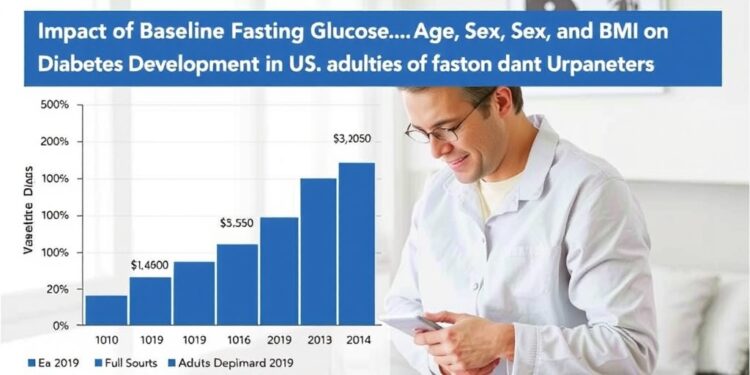The context of diabetes risk has been expanding significantly within the medical community, especially as global diabetes prevalence continues to rise. A recent retrospective cohort study featuring a robust sample of 44,000 individuals has provided new insights into the multifactorial nature of diabetes development. Researchers have identified fasting plasma glucose levels, age, body mass index (BMI), and male sex as significant contributors to diabetes risk. This comprehensive study not only emphasizes the importance of individual factors but also highlights their interactions, painting a vivid picture of diabetes susceptibility.
Fasting plasma glucose serves as a critical biomarker in diabetes diagnostics. It reflects the body’s glucose metabolism, where elevated levels indicate insulin resistance or impaired glucose tolerance. Researchers have quantitatively measured the correlation between higher plasma glucose levels and the likelihood of diabetes development. The study underscored the necessity for clinicians to routinely monitor glucose metrics, especially in populations identified as high-risk. This aligns with preventive healthcare approaches aimed at early detection and intervention.
Furthermore, age plays a pivotal role in diabetes risk stratification. The findings revealed that as individuals age, their risk of developing diabetes escalates significantly. This could be attributed to a combination of factors, including decreased physical activity levels, hormonal changes, and the cumulative effect of lifestyle choices over the years. The study advocates for tailored healthcare strategies that consider age-related risks, augmenting traditional prevention methods with age-specific interventions.
Body mass index (BMI) emerged as another critical parameter in understanding diabetes risk. A direct correlation was found between higher BMI values and the likelihood of developing diabetes. Increased body weight contributes to insulin resistance, leading to impaired glucose regulation. The authors of the study strongly recommend lifestyle modifications, including diet and exercise, as foundational strategies for managing BMI. Such interventions could substantially diminish the risk of diabetes, fostering a healthier population in the long term.
In addition to these factors, sex differences also influenced diabetes development. The study highlighted that men, on average, had a higher risk of developing diabetes compared to women. This disparity might be traced back to biological differences, social behaviors, and the prevalence of conditions associated with diabetes, such as cardiovascular disease. Understanding these nuances is essential for designing gender-sensitive prevention programs that address the specific health needs of both men and women.
The results of this comprehensive study shed light on the substantial variability in diabetes risk, reinforcing the idea that a one-size-fits-all approach is inadequate. The researchers suggest refining risk categorization tools, integrating the identified factors to create a more personalized diabetes risk profile. This advancement has the potential to enhance clinical decision-making, enabling healthcare professionals to implement targeted interventions for individuals at heightened risk.
As the diabetes landscape continues to evolve, the implications of this study extend beyond risk assessment into the realms of treatment and prevention. By highlighting the interactive effects of various risk factors, the research suggests that interventions should not focus solely on one criterion. A holistic approach, considering the interplay of glucose levels, age, BMI, and sex, will likely yield better outcomes in diabetes management.
Moreover, these findings underscore the urgency for public health initiatives aimed at increasing awareness of diabetes risk factors among different demographics. Educational campaigns that resonate with various age groups and address gender disparities can significantly contribute to early detection and preventive measures. Incorporating lifestyle education into regular healthcare practices can foster a proactive mindset toward diabetes prevention, influencing healthier choices across populations.
While this study propels current understanding forward, it also opens doors for future research. Validation of the risk categorization tool across diverse populations will enhance its applicability and reliability. Researchers are encouraged to explore how cultural, geographic, and socioeconomic factors influence diabetes risk, leading to comprehensive strategies that span global health paradigms.
Furthermore, the findings from this research highlight the importance of continued funding and support for diabetes research. Engaging in multisectoral collaborations involving academia, healthcare providers, and policymakers can facilitate innovations in diabetes prevention and treatment. Investments aimed at understanding the intricate relationship between various risk factors and diabetes can lead to groundbreaking advancements in healthcare.
In conclusion, the implications of this retrospective cohort study are profound, inviting both clinical practitioners and researchers to reevaluate traditional approaches to diabetes risk. As healthcare continues to adapt to emerging research, prioritizing a multifaceted understanding of diabetes susceptibility is essential for driving effective interventions. The journey toward better management of diabetes starts with recognizing the interplay of diverse factors that influence risk and embracing an integrative approach to healthcare.
Ultimately, this study serves as a crucial reminder that addressing diabetes effectively requires more than just understanding individual risk factors; it necessitates a holistic view regarded through the lens of human diversity. By fostering greater awareness, tailoring interventions, and enhancing research efforts, the medical community can make considerable strides in combating the diabetes epidemic, ultimately reducing morbidity and mortality associated with this chronic condition.
Subject of Research: Factors Contributing to Diabetes Risk
Article Title: Understanding the Interplay of Age, BMI, Sex, and Glucose Levels in Diabetes Development
News Publication Date: October 2023
Web References: [Link to the study]
References: [Citation of the study]
Image Credits: [Not applicable]
Keywords: Diabetes, Risk Factors, Fasting Plasma Glucose, Age, Body Mass Index, Gender Differences, Preventive Healthcare.
Tags: Okay





